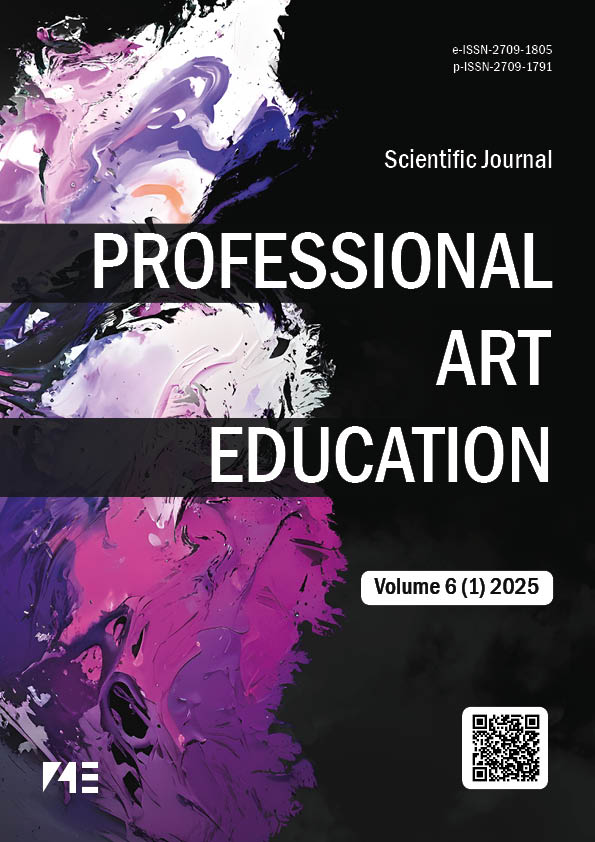Singing as a means of speech correction in preparing prospective special-education teachers in the people’s republic of China
DOI:
https://doi.org/10.34142/27091805.2025.6.01.12Keywords:
singing, speech correction, special education, PRC, music therapy, eurhythmics, bachelor level, readiness, competencies, arts integrationAbstract
The article examines the theoretical foundations and practice-oriented approaches to using singing as a tool for speech correction in the training of bachelor’s-level special education teachers in the People’s Republic of China (PRC).
Methods and methodology. The methodology combines a comparative analysis of PRC curricula and standards, a structural-functional analysis of readiness components, a content analysis of dissertations and scholarly sources, and the modeling of assessment criteria and indicators. The study applies the following principles: interdisciplinarity (speech-language pathology—music pedagogy—psychology), practice-oriented learning (learning by doing), cultural sensitivity, and digital verification/monitoring of changes in speech parameters.
Scientific novelty. The novelty lies in highlighting the readiness of future PRC special-education teachers to use singing for the speech correction of children with special educational needs—readiness that comprises motivational, cognitive, operational-activity, and reflective components—and in defining the system of pedagogical conditions for implementing the proposed training structure.
Results. The structure of readiness is articulated as follows: (a) motivational orientation toward using singing; (b) cognitive awareness of the principles of speech-language pathology, vocal pedagogy, and the psychophysiology of speech; (c) operational-activity capacity to design vocal-corrective sessions, select repertoire, and individualize interventions; (d) reflective ability for self-assessment and adjustment of actions. The study substantiates the need for interdisciplinary integration (speech-language pathology—music therapy—vocal pedagogy), practice-oriented learning in partnership with schools and speech-language clinics, the use of culturally sensitive repertoire, and digital tools for monitoring speech dynamics. It describes integrated modules – «Music and Speech», «Vocal Rehabilitation for Children», practical singing sessions in a speech-therapy context, and training in emotional-communicative interaction—and identifies methods such as vocal-breathing exercises, eurhythmics, improvisational singing, intonation–movement techniques, articulatory-phonetic games, and multimedia interactive technologies.
Conclusions. It is demonstrated that singing is an effective tool for the speech correction of children with special educational needs; the structure of readiness for professional activity among future special-education specialists is summarized. The practical significance lies in the potential to standardize university modules and implement inter-university practice and internship formats. Prospects for further research include expanding the evidence base for specific vocal protocols, improving digital monitoring tools, and adapting instructional materials across cultures.
Downloads
References
Adriaansen, A., Cloete, E., & de Bodt, M. (2022). Effects of voice therapy in children with vocal fold nodules: A systematic review [Ефекти голосової терапії у дітей з вузликами голосових складок: систематичний огляд]. International Journal of Language & Communication Disorders, 57(5), 1032–1046. https://doi.org/10.1111/1460-6984.12754
Adriaansen, A., Meerschman, I., Van Lierde, K., & D'haeseleer, E. (2022). Effects of voice therapy in children with vocal fold nodules: A systematic review. Ghent University Repository. https://biblio.ugent.be/publication/8759397
Al Kadi, M., Alfawaz, M. A., & Alotaibi, F. Z. (2022). Impact of voice therapy on pediatric patients with dysphonia and vocal nodules: A systematic review. Cureus, 14(4), e24433. https://doi.org/10.7759/cureus.24433
Al-Kadi, M., Alfawaz, M. A., & Alotaibi, F. Z. (2022). Impact of voice therapy on pediatric patients with dysphonia and vocal nodules: A systematic review [Вплив голосової терапії на дітей з дисфонією та вузликами голосових складок: систематичний огляд]. Cureus, 14(4), e24433. https://doi.org/10.7759/cureus.24433
Angadi, V., Croake, D., & Stemple, J. (2019). Effects of vocal function exercises: A systematic review [Ефекти «вокальних функціональних вправ»: систематичний огляд]. Journal of Voice, 33(1), 124.e13–124.e34. https://doi.org/10.1016/j.jvoice.2017.08.031
Braden, M. N., & Thibeault, S. L. (2020). Outcomes of voice therapy in children with benign vocal fold lesions [Результати голосової терапії у дітей із доброякісними ураженнями голосових складок]. International Journal of Pediatric Otorhinolaryngology, 136, 110121. https://doi.org/10.1016/j.ijporl.2020.110121
Chai, L. (2023). Music therapy and rehabilitation training for children with speech impairment [Музикотерапія та реабілітаційне тренування дітей із мовленнєвими порушеннями]. MEDS Public Health and Preventive Medicine, 3(1), 58–65. https://doi.org/10.23977/phpm.2023.030109
Christiner, M., & Reiterer, S. M. (2013). Song and speech: Examining the link between singing talent and speech imitation ability [Пісня та мовлення: зв’язок між вокальними здібностями та наслідуванням мовлення]. Frontiers in Psychology, 4, 874. https://doi.org/10.3389/fpsyg.2013.00874
General Office of the State Council of the PRC. (2015). Opinions on comprehensively strengthening and improving aesthetic education in schools [Про всебічне посилення та вдосконалення шкільної естетичної освіти]. http://www.gov.cn/zhengce/content/2015-09/14/content_10158.htm
Merrett, D. L., Peretz, I., & Wilson, S. J. (2014). Neural and cognitive mechanisms of singing: A perspective on speech–music relations [Нейронні й когнітивні механізми співу: погляд на зв’язки мовлення й музики]. Frontiers in Neuroscience, 8, 390. https://doi.org/10.3389/fnins.2014.00390
Ministry of Education of the PRC. (2022). MOE releases compulsory education curriculum program and standards (2022 edition) [МОН КНР: оприлюднення Програми та стандартів навчальних предметів обов’язкової освіти (ред. 2022)]. https://en.moe.gov.cn/news/press_releases/202205/t20220507_625532.html en.moe.gov.cn
Papageorgi, I., Welch, G. F., & Lonie, B. (2022). Singing and social identity in young children [Спів та соціальна ідентичність у дітей молодшого віку]. Frontiers in Psychology, 13, 823229. https://doi.org/10.3389/fpsyg.2022.823229
Rinta, T., & Welch, G. F. (2008). Should singing activities be included in speech and voice therapy for prepubertal children? [Чи слід включати спів у логопедичну/голосову терапію дітей до пубертату?] Journal of Voice, 22(1), 3–19. https://doi.org/10.1016/j.jvoice.2006.08.002
Sydorenko, O. (2020). Вокально музичні технології в роботі з дітьми з порушеннями мовлення. Journal of Ukrainian Speech Therapy, 12(2), 34–48. https://journals.uran.ua/swe/article/download/2520-6230.20.3.7./pdf_59
Titze, I. R. (2006). Voice training and therapy with a semi-occluded vocal tract: Rationale and scientific underpinnings [Тренування голосу та терапія із напівоклюзією вокального тракту: обґрунтування й наукові засади]. Journal of Speech, Language, and Hearing Research, 49(2), 448–459. https://doi.org/10.1044/1092-4388(2006/035)
Welch, G. F., Himonides, E., Saunders, J., Papageorgi, I., & Sarazin, M. (2014). Singing and social inclusion [Спів та соціальна інклюзія]. Frontiers in Psychology, 5, 803. https://doi.org/10.3389/fpsyg.2014.00803
Welch, G., Himonides, E., Saunders, J., Papageorgi, I., & Sarazin, M. (2014). Singing and social inclusion. Frontiers in Psychology, 5, Article 803. https://doi.org/10.3389/fpsyg.2014.00803
Бондар, В. (2017). Методичні рекомендації з корекційної музичної роботи у логопедичній практиці. Харків: ХДПУ.
Міністерство освіти і науки України. (2019). Про затвердження Базового компоненту дошкільної освіти (нова редакція). https://mon.gov.ua/npa/pro-zatverdzhennya-bazovogo-komponenta-doshkilnoyi-osviti-derzhavnogo-standartu-doshkilnoyi-osviti-nova-redakciya
Downloads
Published
License
Copyright (c) 2025 Чай Ліхуа (Автор)

This work is licensed under a Creative Commons Attribution-NonCommercial 4.0 International License.














